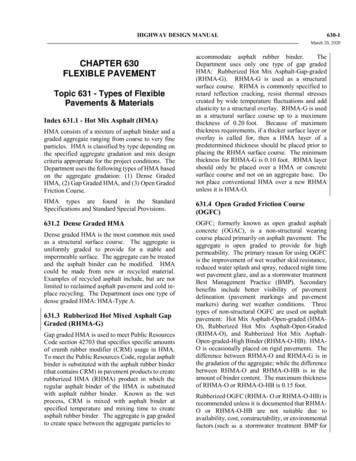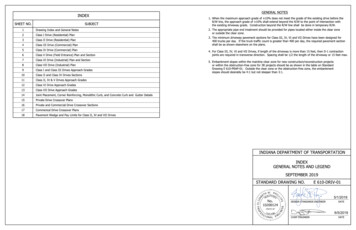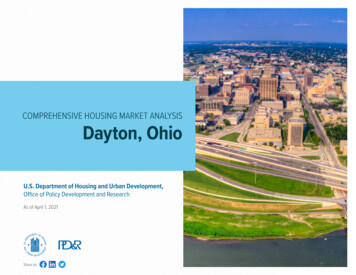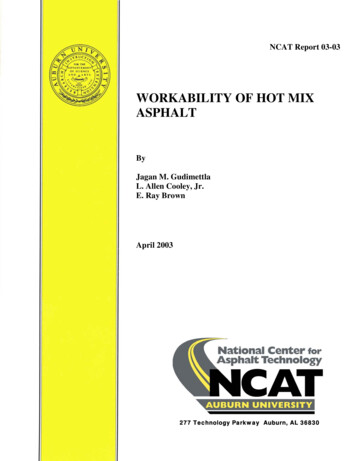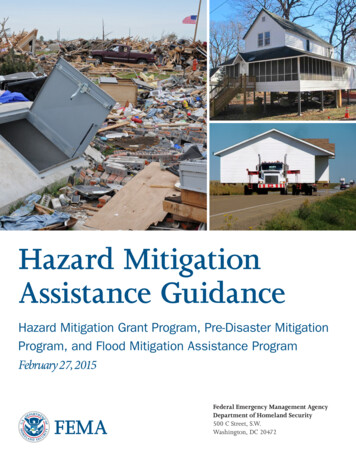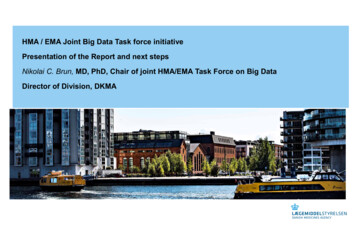
Transcription
HMA / EMA Joint Big Data Task force initiativePresentation of the Report and next stepsNikolai C. Brun, MD, PhD, Chair of joint HMA/EMA Task Force on Big DataDirector of Division, DKMA
The landscape is changing rapidly – the challenges numerous‒ Traditionally we have relied on RCTsRandomised double-blind placebocontrolled studies for evidence – thisis the best way to eliminate bias andget the best source of information oneffect/safety of a single intervention/therapy‒ The Goal: Effectiveness in theintended target populations issomething else, however.‒ When can we start trusting Big Databased evidence without reverting to100% empirical thinking?‒ How can we ensure adequateevidence for regulatory decisionmaking214. MAJ 2019“No amount of observations of white swans canallow the inference that all swans are white, butthe observation of a single black swan is sufficientto refute that conclusion.”— David Hume (1711-1776)
Empirical theory is not the final answer – Bias is (still) important!When is an observation the truth?When are a LOT of observations the truth?How can Real World Evidence help us predict future observations?1711-1776
How can large volumes of data support decision making?IHD mortality(floating absolute risks and 95% CI)IHD mortality(floating absolute risks and 95% CI)IHD mortality(floating absolute risks and 95% CI)Ischaemic Heart Disease versus SBP for 5K vs 50K vs 500K people in the Prospective StudiesCollaboration (PSC, Oxford, UK, courtesy Rory Collins)4
NCB1From Small molecules/MAbs Treatment ofdisease5To Advanced therapy Early intervention Biosystem modification
Folie 5NCB1forebyggende behandlingNikolai Constantin Brun; 28.02.2019
FromTo One size fits all6 Precisionmedicine14-05-2019 Thomas Senderovitz 2017
PrecisionmedicineGenomics ProteomicsClinical data714-05-2019ImagingWearablesSoMe data
Present regulatory paradigmStructured dataClinical TrialsLess structured dataBenefit/riskDrug developmentRCTs 10 yearsPharmacovigilancePost approval SurveillanceApproval8HTA
Future regulatory paradigm?Early B/Rassessment andConditional/Restrictive approvalContinousscientific ”dialog”RCT-basedsubmissionRWD /-Ongoing B/R assessments andPotential approval changesContinous analysis of RWDRCT /-
Two important organisations – one goalAn agency of the European Union
What is Big Data ?Extremely large – VolumeComplex and multi-dimensional – VariableUnstructured and heterogeneous – VarietyRegulatory dataAccumulating rapidly – Velocity (ADR, sales, Safety updates,PASS, PAES)Published literature‘Omic data(Genetic, proteomic,metabolomic)Clinical databases(Prescriptions, EHRs andregistries)Imaging dataClinical trialdataDatasourcesSocial mediadata/mhealthVast scope of Big data we need to prioritise – Value11What do we need? reliable evidence to support regulatory decusions – Value
Current Regulatory Landscape Multiple challenges inthe use of RWD Non clinical models failto mirror humandisease Increasing reporting ofADRs Monitoring the impact ofrisk minimisationmeasures Long term validation ofdigital/ surrogateendpoints Patient access to newmedicines Unknowngeneralisability of RCTs Limited size of clinicaldatabase at approval Transparency of data B/R evaluated one andrarely in special/ highrisk orisation
Future Regulatory Challenges More complex trialdesigns Greater use of RWD acrossthe product life cycle Growth in biomarker use Increasing numbers ofproducts unable to alignwith traditional drugdevelopment pathway Personalised medicine AI algorithms, moreunregulated players e.g.Google Increased incorporation ofcomposite endpoints/PROMS Greater development ofpreventative medicines More combinationtherapies Personalisation of doseand risk profiles Greater use of modellingand simulationapproaches Incorporation of patientpreferences into isation
HMA-EMA Joint Big Data TaskforceThe Task Force should characterise relevant sources of bigdata and define the main format, in which they can beexpected to exist inIdentify areas of usability and applicability of dataGap analysis – describe the current status of expertise,future needs and challengesThe Task Force will generate a list of recommendationsand Big Data Roadmap14Trends in big data
DeliverablesGap AnalysisSurvey of NCAs andpharmaceutical sBIGDATAData Analytics subgroup report end of Q1 2019ADR dataCharacterisation of the datalandscape and detailed table ofprioritised recommendationsClinical trialdataSocialmedia/m healthSubgroup ReportsSummary reportSet of core recommendations(Technical annexes not forpublication)15
Core recommendationsData Standardisationcomponents underpinningacceptabilityData QualitySkills and knowledgeCommunication & EngagementData AnalyticsData Sharing and AccessData LinkageHorizontal cross cutting recommendations – next steps to target priority areas16
Data StandardisationPromote use of global, harmonised and comprehensive datastandards to facilitate interoperability of data 17Minimise the number of standards; strongly support the use ofavailable global data standards or the development of new standards infields where none are available to ensure early alignmentWhere data cannot be standardised at inception, establish the regulatoryrequirements to confirm the validity of mapped dataPromote use of global open source standardsStandards should be platform independent and appropriatelyvalidated.CDISC European Interchange May 2019
Data QualityCharacterisation of data quality across multiple data sources is essential tounderstand the reliability of the derived evidence Characterise and document data quality in a sustainable EU inventory. Establish minimum sets of data quality standards. Where possible,quality attributes e.g. compliance to GCP requirements should beintegrated to facilitate selection of appropriate data sets for analysis. Implement data quality framework/attributes for big data sets. Establish a clear framework for the validation of innovativebioanalytical methods e.g. ‘omics.18CDISC European Interchange May 2019
Data Sharing and AccessThe development of timely, efficient and sustainable frameworks for datasharing and access is requiredFurther support mechanisms are needed to promote a data sharing culture 19Strongly recommend the establishment of distributed data networksEstablish disease-specific minimum data elements to enable harmonisation ofdataRequire the submission of data management plansPromote mandatory sharing of the analysis arising from data sharing activitiesPromote the sharing of qualified modelsSupport the development of policy initiatives to drive a data sharing cultureDevelop guidance for robust data governance and data anonymisationCDISC European Interchange May 2019
Data Linkage and IntegrationPromote mechanisms to enable data linkage to deliver novel insightsFacilitate harmonisation of similar datasets 20Encourage sharing of raw data, associated meta-data and processeddata to enable meaningful data linkage whilst complying with theobligations in data processing set forth in the GDPR.Data linkage and timely data access will require proactive mapping andvalidation.Support mechanisms to maintain up to date mappings acrossterminologies.Promote the inclusion of medicinal treatments and clinical outcomedata relevant to regulatory questions in public databases.CDISC European Interchange May 2019
Data Analytics 21Develop clear frameworks to enable the validation of analytical approaches todetermine if they are appropriate to support regulatory decision making Promote new analytical approaches for modelling of big data setsMove the analysis to the dataMake publicly available data analysis plans for studies submitted for regulatoryapproval.Support, define and validate innovative outcome measures which leverageadditional information from high-frequency or high-dimensional data.Strongly support novel analytics approaches to interrogate unstructured dataPromote the increased utilisation of scientific advice and the EMA QualificationAdvice process to enable regulators to influence more mature approaches.Form an advisory group to explore: the applicability of novel analytics methodologies for regulatory decisions; suitable data standards, IT architecture and tools for evidence generation.CDISC European Interchange May 2019
Data StandardisationPromote use of global,harmonised andcomprehensive datastandards to facilitateinteroperability of dataMedical devicesregulation (MDR) / Invitro DiagnosticsRegulationEnsure effectiveimplementation of the newregulations for devices andin-vitro diagnostics (IVDs)associated with the use ofmedicinal productsMonitor its impact indelivering safe and effectivedevices and IVDs22Data QualityCharacterisation of dataquality across multipledata sources is essentialto understand thereliability of the derivedevidenceData Sharing and AccessThe development of timely,efficient and sustainableframeworks for data sharingand access is requiredFurther support mechanismsare needed to promote a datasharing cultureData Linkage andIntegrationPromote mechanisms toenable data linkage todeliver novel insightsFacilitate harmonisationof similar datasetsCommunication and EngagementProactive regulatory engagement with externalstakeholders relevant to the Big Data Landscape isneeded in order to influence strategy and ensureregulatory needs are highlighted.RegulatoryacceptabilityRegulatory guidance isrequired on theacceptability of evidencederived from Big datasources.Skills and knowledgeRegulators must beequipped with the newskills required for theseemerging areasData AnalyticsDevelop clear frameworks toenable the validation ofanalytical approaches todetermine if they areappropriate to supportregulatory decision makingPromote new analyticalapproaches for modelling ofbig data sets for regulatorypurpose
Task Force Conclusions Big data offers the possibility to derive novel insights to support decision making butalso brings unknowns around data quality and hence the robustness of the evidencegenerated A regulatory strategy is required now to determine how and when in the product lifecycle the utilisation of such data can bring value There is an urgent need to ensure the regulatory network has sufficient expertise tointerpret and critically assess big data The current reports sets out in some detail ‘the what‘ but ‘the how‘ and ‘the when‘will need further work and in the view of the Task Force requires a extension of thecurrent mandate for up to 12 months with an interim assessment as 6 months. Thiswill allow the data analytics group to complete their work and develop the scope forfuture work.23
Next steps :‘The How’24
Next stepsWe need to move from well documented issues and theoretical solutionsto practical, feasible and concrete actions.Each subgroup will consider the recommendations relevant to theirgroup and prioritise down to 3-5 key recommendations.Prioritisations will be based on strategic importance, stakeholderspriority, regulatory impact, potential public heath impact and feasibility.Recommendations should be finalised by Q1 of 2020.In order to deliver on the vision, building collaborations betweenstakeholders will be key.25CDISC European Interchange May 2019
VisionOur vision is a strengthened regulatory system that canefficiently integrate data analysis into its assessmentprocesses to improve decision making. This will be supported byknowledge of data sources, their quality and their relevance for theEuropean population, continual optimisation of data quality andanalytical approaches and promotion of a secure and ethical datasharing culture. Training and external collaborations will be key inorder to build expertise.Knowing when and how to have confidence in noveltechnologies and the evidence generated from big data willbenefit public health by accelerating medicines development,improving treatment outcomes and facilitating earlier patient access to26CDISC European Interchange May 2019newtreatments.
Next csObservationaldataResearchInitiativesData Analytics subgroupBIGDATAADR dataDataanalyticsClinical trialdataSocial media/m health27Datastandardsand qualityCDISC European Interchange May 2019RegulatoryacceptabilityDevices andin vitrodiagnostics
Promote the use of global, harmonised andcomprehensive standards to providetransparency around quality, enhanceinteroperability and facilitate linkage acrossmultiple datasetsSupport and maintain relevant skills inthe regulatory networkPromote bidirectional communicationwith external stakeholders to influencestrategy and ensure regulatory needsare highlightedIdentify potential barriers for datasharing and analysesTo strengthen and fosterresearch to create anenvironment thatsupports the developmentof innovative approachesPolicy,training andcommsResearchInitiativesTo optimise the use ofhealthcare related data tosupport regulatorydecisionsTo define the elements whichresults in evidence that is ‘fitfor purpose’.RegulatoryacceptabilityDataStandardsand QualityDataAnalyticsSupport the developmentand validation of novelanalytical approachesDevices andIn vitroDiagnosticsEstablish effective co-ordination betweennotified bodies and NCAs to deliver safeand effective devices and in vitrodiagnostics
Thank you for your attentionAny questions?2914. MAJ 2019NCBR@DKMA.DK
Any questions?Further information: NCBR@DKMA.DKFollow us on@EMA News
HMA / EMA Joint Big Data Task force initiative Presentation of the Report and next steps Nikolai C. Brun, MD, PhD, Chair of joint HMA/EMA Task Force on Big Data Director of Division, DKMA. The landscape is changing rapidly - the challenges numerous ‒ Traditionally we have relied on RCTs Randomised double-blind placebo controlled studies for .
